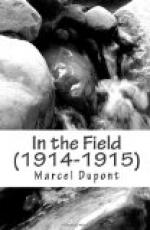We had hardly left him when we caught sight of the reconnoitring party of my comrade O., and were overjoyed to find that he had come back unscathed with all his men. And yet he had had to face a fair number of dangers—attacks by cyclists and pursuit by cavalry. At Crezancy, where he arrived at three o’clock in the morning, he found the village occupied and strongly held. There is only one bridge over the railway there, and that is at the other end of the village. By good luck he was able to get hold of one of the inhabitants; and he forced him, by holding his revolver to his head, to guide him by all sorts of byways so as to make a circuit without attracting attention and get to the bridge. There he set forward at a gallop, and passed, in spite of being fired on by the guard. At last he reached the Marne. The only bridge he found intact for crossing the river was the bridge at Jaulgonne, a slender, fragile suspension-bridge, but one that we should be very glad to find if there was still time to use it. He then hurried back through the woods, but not without having to run the gauntlet of rifle fire several times more. He brought back information which was to guide our advance.
It was seen at once that there was not a minute to lose. The Captain detached me immediately, with my troop, to act as a flank-guard along the line of wooded crests by which the road on the right was commanded, whilst F., with his troop, crossed the Surmelin and the railway which runs alongside of it, and went to carry out the same task on the other side of the valley.
My job was difficult enough. In fact, the heights, which look down upon the course of the Surmelin to the east, consist of a series of ridges separated by narrow ravines at right angles to the river, and these we had to cross to continue our route towards the north. The enemy seemed to have withdrawn completely from this region, and the cannon fire in the distance towards the east could hardly be heard. At last, at about seven o’clock in the morning, we debouched upon the valley of the Marne.
Whilst I sent some troopers along the road which winds by the Surmelin to keep in touch with my Captain, I carefully inspected the right bank of the Marne with my glasses. The scene would have tempted a painter, and the labours of war do not prevent one from enjoying the charm of such delightful pictures. The sun was gradually dispersing the mist of the sullen morning, and was beginning to gild the wooded heights which look down upon the two banks of the river. Everywhere a calm was reigning, which seemed to promise a day of exquisite beauty. We might have fancied that we were bent on some peaceful rural work favoured by a radiant autumn morning. The Marne in this region winds in graceful curves. It flows limpid and clear through a narrow valley carpeted with green meadows and bordered, right and left, by gentle hills dotted with woods. At our feet, peeping from the poplars and beeches on the bank, we saw the white houses of dainty villages—Charteves, Jaulgonne, Varennes, and Barzy.




